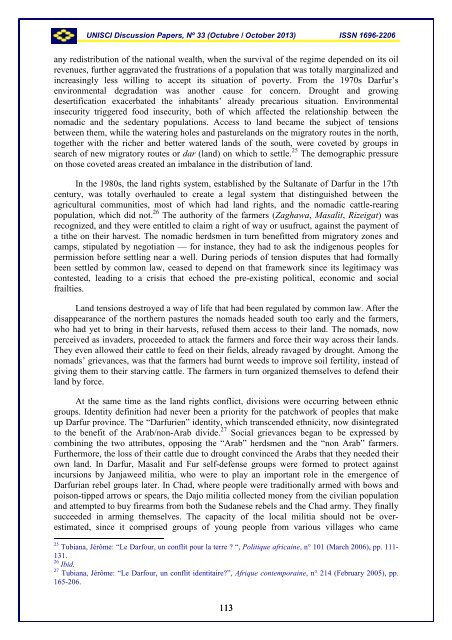UNISCI - Universidad Complutense de Madrid
UNISCI - Universidad Complutense de Madrid
UNISCI - Universidad Complutense de Madrid
You also want an ePaper? Increase the reach of your titles
YUMPU automatically turns print PDFs into web optimized ePapers that Google loves.
<strong>UNISCI</strong> Discussion Papers, Nº 33 (Octubre / October 2013) ISSN 1696-2206any redistribution of the national wealth, when the survival of the regime <strong>de</strong>pen<strong>de</strong>d on its oilrevenues, further aggravated the frustrations of a population that was totally marginalized andincreasingly less willing to accept its situation of poverty. From the 1970s Darfur’senvironmental <strong>de</strong>gradation was another cause for concern. Drought and growing<strong>de</strong>sertification exacerbated the inhabitants’ already precarious situation. Environmentalinsecurity triggered food insecurity, both of which affected the relationship between thenomadic and the se<strong>de</strong>ntary populations. Access to land became the subject of tensionsbetween them, while the watering holes and pasturelands on the migratory routes in the north,together with the richer and better watered lands of the south, were coveted by groups insearch of new migratory routes or dar (land) on which to settle. 25 The <strong>de</strong>mographic pressureon those coveted areas created an imbalance in the distribution of land.In the 1980s, the land rights system, established by the Sultanate of Darfur in the 17thcentury, was totally overhauled to create a legal system that distinguished between theagricultural communities, most of which had land rights, and the nomadic cattle-rearingpopulation, which did not. 26 The authority of the farmers (Zaghawa, Masalit, Rizeigat) wasrecognized, and they were entitled to claim a right of way or usufruct, against the payment ofa tithe on their harvest. The nomadic herdsmen in turn benefitted from migratory zones andcamps, stipulated by negotiation — for instance, they had to ask the indigenous peoples forpermission before settling near a well. During periods of tension disputes that had formallybeen settled by common law, ceased to <strong>de</strong>pend on that framework since its legitimacy wascontested, leading to a crisis that echoed the pre-existing political, economic and socialfrailties.Land tensions <strong>de</strong>stroyed a way of life that had been regulated by common law. After thedisappearance of the northern pastures the nomads hea<strong>de</strong>d south too early and the farmers,who had yet to bring in their harvests, refused them access to their land. The nomads, nowperceived as inva<strong>de</strong>rs, procee<strong>de</strong>d to attack the farmers and force their way across their lands.They even allowed their cattle to feed on their fields, already ravaged by drought. Among thenomads’ grievances, was that the farmers had burnt weeds to improve soil fertility, instead ofgiving them to their starving cattle. The farmers in turn organized themselves to <strong>de</strong>fend theirland by force.At the same time as the land rights conflict, divisions were occurring between ethnicgroups. I<strong>de</strong>ntity <strong>de</strong>finition had never been a priority for the patchwork of peoples that makeup Darfur province. The “Darfurien” i<strong>de</strong>ntity, which transcen<strong>de</strong>d ethnicity, now disintegratedto the benefit of the Arab/non-Arab divi<strong>de</strong>. 27 Social grievances began to be expressed bycombining the two attributes, opposing the “Arab” herdsmen and the “non Arab” farmers.Furthermore, the loss of their cattle due to drought convinced the Arabs that they nee<strong>de</strong>d theirown land. In Darfur, Masalit and Fur self-<strong>de</strong>fense groups were formed to protect againstincursions by Janjaweed militia, who were to play an important role in the emergence ofDarfurian rebel groups later. In Chad, where people were traditionally armed with bows andpoison-tipped arrows or spears, the Dajo militia collected money from the civilian populationand attempted to buy firearms from both the Sudanese rebels and the Chad army. They finallysuccee<strong>de</strong>d in arming themselves. The capacity of the local militia should not be overestimated,since it comprised groups of young people from various villages who came25 Tubiana, Jérôme: “Le Darfour, un conflit pour la terre ? “, Politique africaine, n° 101 (March 2006), pp. 111-131.26 Ibid.27 Tubiana, Jérôme: “Le Darfour, un conflit i<strong>de</strong>ntitaire?”, Afrique contemporaine, n° 214 (February 2005), pp.165-206.113
















